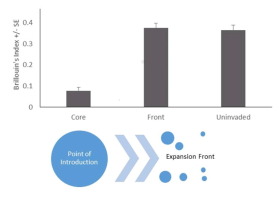当前位置:
X-MOL 学术
›
Int. J. Parasitol.
›
论文详情
Our official English website, www.x-mol.net, welcomes your
feedback! (Note: you will need to create a separate account there.)
The hidden faces of a biological invasion: parasite dynamics of invaders and natives.
International Journal for Parasitology ( IF 3.7 ) Pub Date : 2020-01-23 , DOI: 10.1016/j.ijpara.2019.11.003 Peter Stuart 1 , Linda Paredis 2 , Heikki Henttonen 3 , Colin Lawton 4 , Claudia A Ochoa Torres 5 , Celia V Holland 1
International Journal for Parasitology ( IF 3.7 ) Pub Date : 2020-01-23 , DOI: 10.1016/j.ijpara.2019.11.003 Peter Stuart 1 , Linda Paredis 2 , Heikki Henttonen 3 , Colin Lawton 4 , Claudia A Ochoa Torres 5 , Celia V Holland 1
Affiliation

|
One of the primary drivers of emerging infectious diseases (EIDs) is human intervention via host or parasite translocations. A unique opportunity to study host and parasite dispersal during a bio-invasion currently exists in Ireland due to the introduction of the bank vole (Myodes glareolus) in the 1920s. The continuing range expansion of M. glareolus within Ireland presents a natural large-scale perturbation experiment. This study used the Irish M. glareolus model to conduct a spatiotemporal study analysing the parasite dynamics of native and invasive species throughout their range. Myodes glareolus and native Apodemus sylvaticus were trapped in woodlands across Ireland and surveyed for their helminth parasites. Myodes glareolus in Ireland were found to have lower parasite diversity in comparison to records of M. glareolus from across Europe and A. sylvaticus in Ireland. Increased density of M. glareolus resulted in a dilution effect, with significantly lower levels of parasitism overall in native hosts, where M. glareolus has been established longest. However, three helminth parasite species of A. sylvaticus increased in abundance in the presence of M. glareolus. Furthermore, M. glareolus at the expansion front were less parasitised (lower abundance and prevalence of certain parasites and lower parasite diversity) than M. glareolus from the core population. This "enemy release" is believed to be mediating the continued successful spread of the invader across Ireland. Our results identify two important variables, seasonality and the stage of the invasion, which should not be overlooked when investigating or managing the changing distribution of hosts and their parasites. Studies of bio-invasions and parasite transmission have primarily focused on the invasive host species or the native host species in cases where virulent pathogen spillover is observed. Our results demonstrate how the concurrent study of invasive and native hosts, and the careful identification of their parasite communities, allows the dynamic processes influencing the parasite component and intracommunity to be identified.
中文翻译:

生物入侵的隐藏面孔:入侵者和当地人的寄生虫动态。
新兴传染病(EID)的主要驱动力之一是通过宿主或寄生虫易位的人为干预。由于在1920年代引进了田鼠(Myodes glareolus),因此目前在爱尔兰存在一个独特的机会来研究生物入侵期间的宿主和寄生虫扩散。爱尔兰境内的芒硝支链球菌不断扩大的范围提出了自然的大规模扰动实验。这项研究使用了爱尔兰M. glareolus模型进行时空研究,分析了整个范围内的本地和入侵物种的寄生虫动态。鼠疫鼠和原生姬鼠被困在爱尔兰的林地中,并对其寄生虫进行了调查。与M记录相比,爱尔兰的Myodes glareolus被发现具有较低的寄生虫多样性。来自欧洲和爱尔兰的A. sylvaticus的glareolus。毛细支气管炎的密度增加导致稀释作用,在已建立最长支脉支原体的本地宿主中,总体寄生虫水平明显降低。但是,三种存在的绿头苍耳寄生虫在油状支原体的存在下大量增加。此外,与核心种群相比,扩张前部的耻垢分枝杆菌的寄生虫少(某些寄生虫的丰度和患病率较低,寄生虫的多样性较低)。人们认为,这种“敌人释放”正在调解入侵者在爱尔兰的持续成功传播。我们的结果确定了两个重要变量,季节性和入侵的阶段,在调查或管理宿主及其寄生虫的不断变化的分布时,不应忽视这一点。生物入侵和寄生虫传播的研究主要集中在侵入性宿主物种或在观察到强病原体溢出的情况下的天然宿主物种。我们的研究结果表明,对侵袭性宿主和原生宿主的并行研究以及对寄生虫群落的仔细识别如何能够确定影响寄生虫成分和社区内部的动态过程。
更新日期:2020-01-23
中文翻译:

生物入侵的隐藏面孔:入侵者和当地人的寄生虫动态。
新兴传染病(EID)的主要驱动力之一是通过宿主或寄生虫易位的人为干预。由于在1920年代引进了田鼠(Myodes glareolus),因此目前在爱尔兰存在一个独特的机会来研究生物入侵期间的宿主和寄生虫扩散。爱尔兰境内的芒硝支链球菌不断扩大的范围提出了自然的大规模扰动实验。这项研究使用了爱尔兰M. glareolus模型进行时空研究,分析了整个范围内的本地和入侵物种的寄生虫动态。鼠疫鼠和原生姬鼠被困在爱尔兰的林地中,并对其寄生虫进行了调查。与M记录相比,爱尔兰的Myodes glareolus被发现具有较低的寄生虫多样性。来自欧洲和爱尔兰的A. sylvaticus的glareolus。毛细支气管炎的密度增加导致稀释作用,在已建立最长支脉支原体的本地宿主中,总体寄生虫水平明显降低。但是,三种存在的绿头苍耳寄生虫在油状支原体的存在下大量增加。此外,与核心种群相比,扩张前部的耻垢分枝杆菌的寄生虫少(某些寄生虫的丰度和患病率较低,寄生虫的多样性较低)。人们认为,这种“敌人释放”正在调解入侵者在爱尔兰的持续成功传播。我们的结果确定了两个重要变量,季节性和入侵的阶段,在调查或管理宿主及其寄生虫的不断变化的分布时,不应忽视这一点。生物入侵和寄生虫传播的研究主要集中在侵入性宿主物种或在观察到强病原体溢出的情况下的天然宿主物种。我们的研究结果表明,对侵袭性宿主和原生宿主的并行研究以及对寄生虫群落的仔细识别如何能够确定影响寄生虫成分和社区内部的动态过程。











































 京公网安备 11010802027423号
京公网安备 11010802027423号